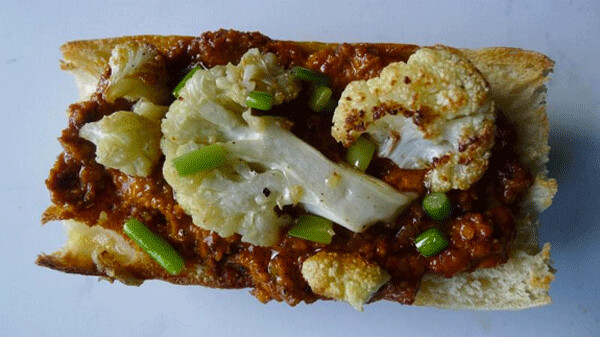Mexican Romesco

Romesco sauce, one of Catalonia’s finest exports, is famous as a dressing for seafood. But the red, nutty condiment also has a place atop many more savory dishes. Eventually, romesco made its way from the Mediterranean to California, along with the likes of olives, grapes and almonds.
In the 1980s, Napa Valley restaurateur Cindy Pawlcyn hired the brothers Ernest and Pablo Jacinto to run the kitchen at her Mustards Grill. Their South-of-the-border version of the Catalonian sauce was a hit, and a celebrated fixture on the menu for years. The modification from Spanish to Mexican romesco is slight, but significant---only the substitution of dried chile for fresh red bell pepper, which thickens the romesco and adds pungency.
“Everything else in the sauce comes from Spain,” explained my friend Marianne Forest, who learned the recipe from Pawlcyn. A restaurateur herself, now a caterer and teacher, Marianne has first-name-only status in the food community of my small town. I was thrilled when she agreed to come to my house and show me how to make Jacinto-style romesco.
Stately, with silvery blond hair and a bright, sharp gaze, Marianne was at home in a foreign kitchen like mine. When it was time to cut a tomato, she reached smoothly into the jungle of utensils at the edge of my counter and extracted the tomato knife, as if pulling a rabbit from a hat. She used the serrated blade to cut a cross on top of each tomato.
Those cuts would make the skins slip off easily, after the broiled tomatoes cooled. In the meantime, almonds would be roasted, a hunk of sourdough would be griddled, and garlic baked in olive oil. “Everything is roasted or toasted,” Marianne said.
Marianne put the ingredients in the blender, in no particular order---”This isn’t some French classic sauce where one thing depends on the next”---and turned it on.
Every few moments she would inspect the slurry with a spoon, gauging progress by the diminishing diameter of the largest pieces of almond. “You don’t want a thin, emulsified sauce,” Marianne cautioned. “You want rustic saucery. It should not be homogenous, or liquefied.”
Before I knew it, we were eating romesco. Delicious off the spoon, with a vibrant mix of strong flavors, the differences in almond chunk size add intrigue, and a feeling that you are eating something from a time before we had machines that could make everything smooth. A time when you actually had to peel the tomatoes.
Per Marianne’s advice, I smeared romesco on a piece of crusty toast soaked in olive oil, and was enchanted. Atop such a piece of sauced bread there is plenty of room for additional morsels of food, like grilled asparagus, roasted cauliflower, or a few leaves of spicy greens. Since then I have noticed a pattern: when bread and romesco sauce are both within reach, I will keep eating until one of them runs out.
Romesco a los hermanos Jacinto
In early summer, good garlic heads can be hard to find, but garlic flowers, aka scapes, are abundant. The sauce has even more texture when made with scapes instead of cloves.
The original recipe contains toasted bread. As a gluten-free alternative, Marianne suggested adding extra almonds and skipping the bread. I tried that and preferred that version, especially when gluttonously smeared on a glutenous hunk of toasted sourdough.
Romesco a las hermanos Jacinto was made with whole dried chile pods, but chile powder makes a decent batch too. If using powder, it can be a mix of spicy and mild varieties, such as paprika and cayenne, to achieve your desired spice level for the dish while adding enough chile flavor.
If you can find whole dried chile with the right balance of heat and flavor for your taste, then by all means use it. Marianne likes New Mexico and Ancho peppers. Remove the seeds, toast in a pan and soak in water to rehydrate.
Serves 4
One ¾-lb tomato (or a collection of smaller tomatoes)
2 small heads or one large head garlic, separated into cloves and peeled (or scapes)
1 cup olive oil
1 cup almonds (or half a cup of almonds and a slice of toast)
1 tablespoon cayenne powder
1 tablespoon paprika (adjust ration of cayenne to paprika according to your taste)
2 tablespoons red wine vinegar
½ teaspoon salt
Turn the oven to broil. Cut an X on the top of the tomatoes, with the stem scab right in the middle, and place them six inches below the flame. Leave there until you smell something faintly starting to burn, about 10-15 minutes---start paying close attention after 10. When the peels start to dry and even char, turn the tomatoes over and cook similarly.
While the tomatoes are broiling, pour ½ cup of the olive oil into a small baking dish and add garlic cloves. When the tomatoes are charred on both sides, remove them, turn the oven temperature to 300 degrees on bake setting, and put the pan of garlic and oil in the oven. Bake at 300 for 20 minutes. Turn off the heat and leave in the oven to cool.
While that happens, toast the almonds in a dry, thick-bottom pan for 15-20 minutes on low heat. Just a couple of almost burnt almonds means the sauce is right on track for a rustic flavor, but the sauce itself should taste smoky but not burnt. If using bread in the sauce, pan-fry it in olive oil to slightly brown.
Add all of the roasted, toasted and baked ingredients---everything but the last ½ cup of olive oil---to the blender or food processor. Blend on low until the almonds are all chopped in half or smaller---about 30 seconds. Add the last ½ cup of oil, blend on high for about 4 seconds, or until the almond chunks are three millimeters or less.
Serve at room temperature with anything savory, like grilled or roasted vegetables, scrambled eggs. Or that crusty, oily piece of bread.
